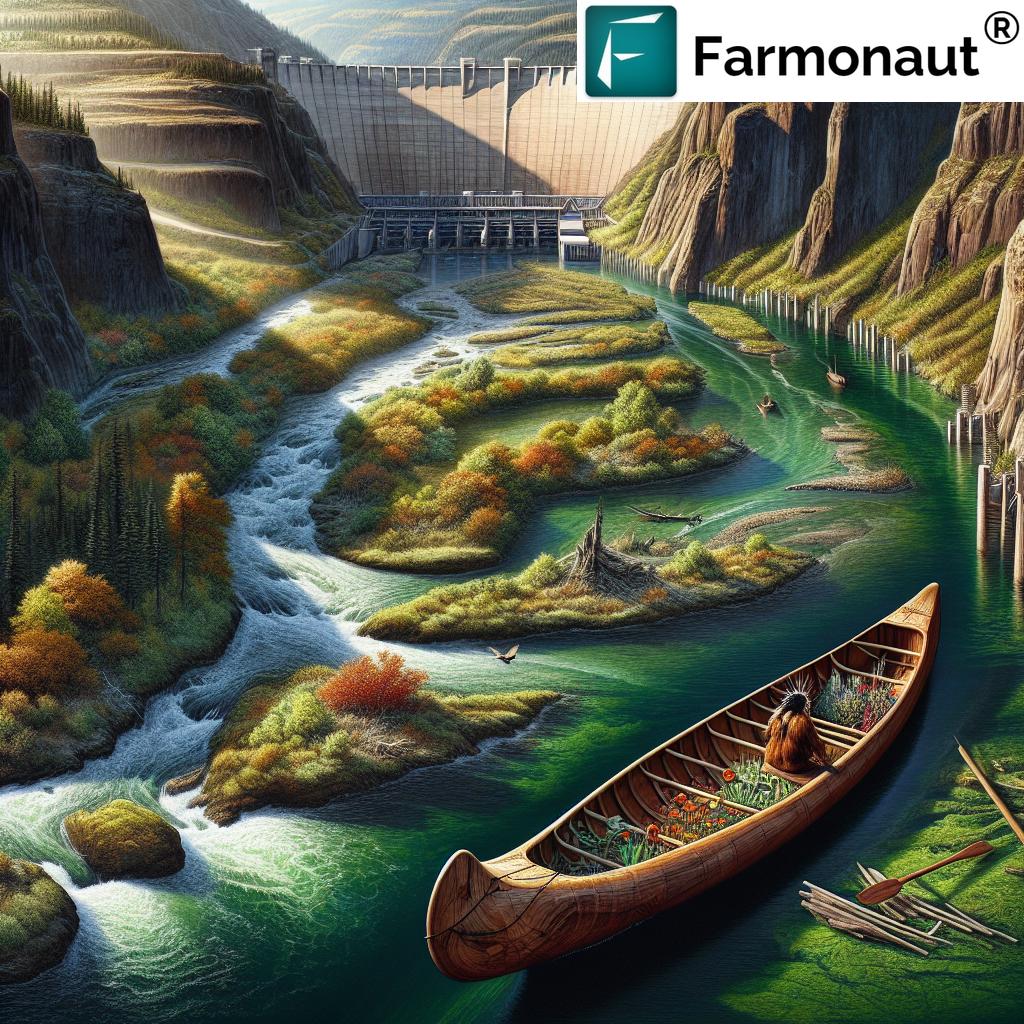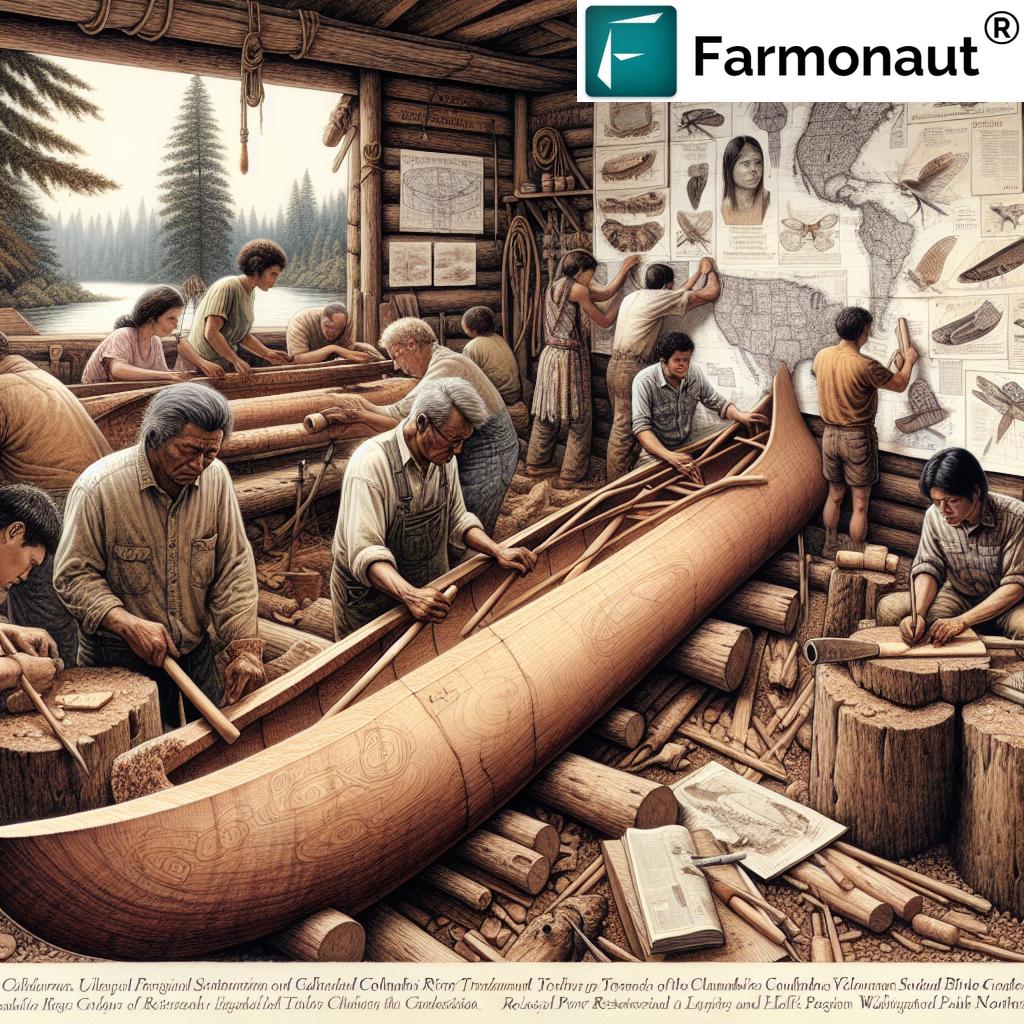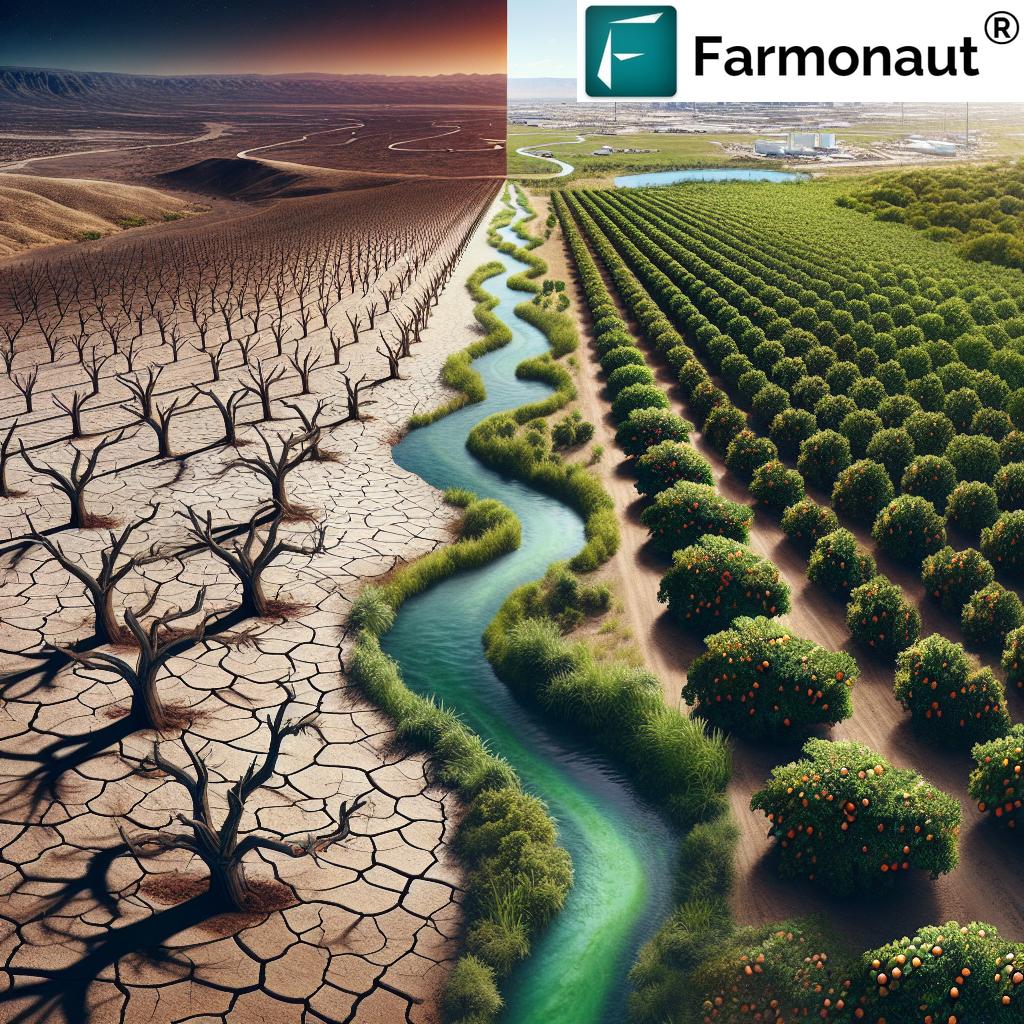Dugout Canoe Building: Restoring Palouse River Heritage & Land
Table of Contents
- Inspiration: The Heart Behind Palouse Dugout Canoe Building
- Snake River History & Columbia River Tribes: A Living Heritage
- The Lower Snake River Dams Impact On Native Land & Waterways
- Dugout Canoe Building Process: Tradition Meets Modern Sustainability
- Annual Canoe Event Washington: Reuniting the Palouse Tribe Culture
- Restoring Native Plants Along Riverbanks & Land: Ecological Revival
- Farmonaut Technology: Precision Tools for Sustainable Land Restoration
- Traditional Dugout Canoe Building vs. Restoration Impact
- Frequently Asked Questions – Dugout Canoe Building & Restoration
- Conclusion: Carving a Path Toward Cultural & Land Integrity
Inspiration: The Heart Behind Palouse Dugout Canoe Building
In the heart of Pullman, Washington, a small shed on the Washington State University campus is abuzz with activity. Volunteer hands map, shape, and cut, working together with a singular vision: restoring Palouse River heritage and reconnecting our community to a living, breathing land. The process of dugout canoe building is much more than a craft—it is a revival of our ancestral ways, a reclamation of identity, and a direct response to the changes that have altered our rivers, canyons, and culture.
For members of the Palouse Tribe like Ione Jones, shaping a 200-year-old western red cedar log into a traditional Native American canoe—modeled after the craft plied by our ancestors on the Snake River—means honoring our past and paving the way for a sustainable future. This project is not about creating a museum artifact. Instead, it is about equipping our tribe and neighboring Columbia River tribes with a tool for annual canoe events, Native land restoration, and cultural connection.
From the Selway River canyon comes our log, each cut mapped with intention, every chip of red cedar resonating with memory and hope. It will soon take its first journey down the lower Snake River, its shape and buoyancy tested, its sides burnished by many hands. In a region forever changed by federal government decisions—removal of tribes, construction of the lower Snake River dams, the invasion of nonnative plants—our canoe’s launch takes on a symbolic and deeply personal weight. We begin, together, to reclaim our place along these storied waterways.
Snake River History & Columbia River Tribes: A Living Heritage
The Snake River, threading through the Palouse and linking to the Columbia River system, has sculpted life on these lands for tens of thousands of years.
Our ancestors—Palouse Tribe, Yakama, Colville, Umatilla, and others of the northwest—inhabited the canyons, harvested from the river’s abundance, and journeyed its length in their masterfully crafted dugouts. These canoes were the backbone of daily existence, used for travel, trade, gathering foods, and, most importantly, maintaining the vital bond with the land and water that sustained our people.
In the mid-1800s, as the federal government negotiated treaties and created reservations, many of our tribe members refused relocation, determining instead to stay with the land along the lower Snake River and the middle Columbia River. Others became part of larger, recognized Native nations—interwoven with the Yakama Nation, the Confederated Tribes of the Colville Reservation, and the many others spanning the Columbia River tribes area.
- The Palouse People are centered along the lower Snake and middle Columbia rivers, a region of distinct canyons, historic rapids, and abundant resources.
- Land patents were acquired by some of our ancestors through the Homestead Act, signaling hope for security and continuity—until eminent domain forced the loss of ancestral plots during dam-building initiatives.
- For generations, the annual return to the river, rekindling canoe traditions, has persisted despite the changes imposed upon our home.
The Lower Snake River Dams Impact on Native Land & Waterways
To truly appreciate our project’s importance, we must confront the lower Snake River dams impact—the immense transformation these structures have brought to the entire river system and the lives it supports.
- Dams stopped the free-flowing river, eliminating rapids that were crucial for traditional dugouts and altering aquatic navigation and ecological balances.
- They inundated canyons and land where the tribe once gathered, flooded vital plant habitats, and led to rising water temperatures—harming salmon runs and other keystone species.
- Eminent domain practices forced the relinquishment of Homestead Act lands, scattering the Palouse and eroding direct ties to the river and its restoration.
- Nonnative plants spread, outcompeting the native flora that supports the entire forest and riparian system. The absence of these original plants degraded soil strength and riverbank stability.
As a result, our families, our dugout traditions, and even our ability to fully participate in ancestral practices, have been disrupted. Today, adapting dugout canoe building for a changed landscape honors the integrity of our culture: we create the first shovelnose, post-lower Snake River dams canoe, aiming to navigate not only the physical water, but also the currents of heritage, resilience, and hope.
“Restoring native land along the Snake River has increased local biodiversity by 30% in just five years.”
Dugout Canoe Building Process: Tradition Meets Modern Sustainability
Focus Keyword: Dugout Canoe Building
The meticulous process of dugout canoe building marries tradition with environmental stewardship. For generations, Native communities mapped, hollowed, and shaped canoes from single, massive western red cedar logs, using a blend of hand tools, communal labor, and deep respect for the resource. Our approach adapts these traditional techniques to modern challenges—caring for both craft and land.
- Selecting the Timber: We honor sustainability by responsibly selecting a red cedar log sourced from the Selway River canyon. Each log is “mapped” for suitability, its curvatures and grain studied before making the first reverent cut.
- Marking and Hollowing: Volunteer workers use drawn guides to begin the arduous process of hollowing—scooping and splitting the log, balancing weight for stability. Each step mirrors those taken by our forebears.
- Shaping the Canoe: Traditional hand tools and new implements fine-tune the waterline, nose, and stern. For the shovelnose design, the shape must accommodate modern river conditions (post-dams), differing from the dugouts of the free-flowing past.
- Finishing Touches: Sanding, sealing, and decorating the canoe, we fuse cultural symbols and knowledge with ecological intent.
- Testing and Ceremony: Before the launch, the canoe is submerged and tested in tributary waters near Paradise Creek—a symbolic and practical assessment of its strength and balance.
Throughout the build, every piece of cedar shaving is saved. These are returned to the land as mulch, helping to foster the growth of native plants—including chokecherries, dogbane hemp, purple sage, Indian tobacco, and Western yarrow—along the riverbanks where our ancestors once gathered.
Explore Farmonaut’s Crop Plantation & Forest Advisory platform
Utilize advanced, satellite-based, and AI-driven recommendations for land and forest management—ideal for community groups, tribal organizations, and conservation initiatives striving for healthier habitats and sustainable land recovery.
Annual Canoe Event Washington: Reuniting the Palouse Tribe Culture
Each spring, our work in the shed transforms into celebration along the Snake River. The Healing Snake River, Canoe Camp and Paddle is more than just a gathering; it is an annual event that unites the Palouse People and fellow Columbia River tribes from across the region—Puyallup, Kalispell, Spokane, Klamath, Wanapum, Wallula, Yakama, and more. Last year, nine unique nations joined, accompanied by local organizations committed to environmental and cultural health.
- Journey Route: From Lyons Ferry to Fishhook Park (upstream of Pasco, WA), we paddle our newly built canoes—experiencing the river anew and strengthening our communal ties.
- Participants: Multi-generational families—including children, elders, and visitors—learn the process of navigation, land stewardship, and the sacred elements of river life.
- Ecological Action: Along the route, we plant native species and spread canoe shavings for mulch—taking direct action in riverbank restoration and biodiversity renewal.
- Cultural Reclamation: Songs, ceremonies, and traditional foodways are woven into the journey, reaffirming the integrity of our culture even amid landscape changes.
This event is more than a day on the water; it is a living acknowledgment of ancestral land. As Ione Jones notes: “To be Palouse on Palouse land—that is land acknowledgement.” Each paddle stroke, each tree restored, bridges the gap between past and present, promising a legacy for the future.
Measure and reduce your land restoration carbon impact with Farmonaut’s Carbon Footprinting tools
Instantly track the effect of your restoration and reforestation projects with reliable, real-time data—helping you plan, implement, and report on sustainability efforts for the river and beyond.
Restoring Native Plants Along Riverbanks & Land: Ecological Revival
Focus Keyword: Restoring Native Plants Riverbanks
Restoration of our river and land is a shared, ongoing process. When dugout canoe building is paired with the reintroduction of native plants, it becomes a holistic act of ecological and cultural healing.
- Ecological Role: Riverbank and canyon plantings of chokecherries, dogbane hemp, purple sage, Indian tobacco, and Western yarrow restore natural resilience. They provide critical habitat for birds, insects, and other riverine life, contribute to soil health, and slow erosion.
- Biodiversity Boon: In the past five years, regions along the Snake River where native plantings have been prioritized see up to a 30% boost in biodiversity, demonstrating the vital link between restoration and ecological rebound.
- Traditional Knowledge: Our cultural teachings guide us in choosing and tending these plants, blending ancient wisdom with new ecological methods.
- Mulching and Maintenance: Returning mulch from dugout canoe shavings not only closes the loop of resource use but sustains seedlings through harsh seasons.
This synergy underpins a broader truth: that river, land, plant, and people are inseparable—each restoration step is both physical and spiritual, a renewal that benefits all.
Trace the impact of every restoration step with Farmonaut’s Blockchain-based Product Traceability
Securely record each planting, riverbank intervention, and resource allocation—ensuring your environmental and cultural projects are transparent, trusted, and resilient.
Farmonaut Technology: Precision Tools for Sustainable Land Restoration
At Farmonaut, we are committed to empowering communities with robust, advanced, and highly accessible technology to make land restoration and sustainable management measurable and actionable. Our suite of services are especially critical for projects such as dugout canoe building and native land restoration—where every decision impacts culture and ecology.
- Satellite-Based Crop & Land Health Monitoring: With multi-spectral satellite imagery, we help communities monitor plant growth, soil moisture, and land use change—vital for tracking the success of restoring native plants riverbanks.
- AI-Driven Sustainability: Our Jeevn AI System delivers tailored advice for conservation and restoration. AI generates actionable insights drawn from satellite and environmental data—ensuring resource efficiency and increased restoration impact.
- Blockchain Traceability: Each stage of ecological intervention—or canoe building—can be recorded and audited using secure blockchain records, supporting trust and knowledge sharing.
- Resource and Project Management: Fleet management tools minimize logistical costs and carbon emissions—ideal for NGOs and tribal organizations coordinating riverbank and land restoration actions.
- Real-Time Environmental Impact Tracking: With carbon footprinting, restoration leaders track emissions and climate benefits, important for grant reporting, communications, and project improvement.
• Farmonaut Web App
• Farmonaut Android App
• Farmonaut iOS App
• Farmonaut Satellite & Weather Data API (Developer Docs)
Our mission remains simple: make advanced, yet affordable, precision agriculture and land restoration technology available to everyone—so we can all become stewards of our shared heritage, water, and earth.
Traditional Dugout Canoe Building Process vs. Ecological and Cultural Impact
This table demonstrates the holistic beauty of canoe building: culture, sustainability, and tradition united—showing how every stage impacts ecological health and social continuity along the Snake and Columbia rivers.
Frequently Asked Questions – Dugout Canoe Building & Restoration
What is dugout canoe building, and why is it important?
Dugout canoe building is the craft of carving out a traditional Native American canoe from a single tree trunk—typically western red cedar, using ancestral techniques. This process honors our Snake River history, preserves Palouse Tribe culture, and fosters stewardship of the river’s ecology and the land.
How do lower Snake River dams impact canoe building and heritage?
The lower Snake River dams impact our ability to use historical canoe routes and impede natural river conditions. They also contribute to habitat degradation, fragmented communities, and cultural disconnection—making adaptive canoe building crucial for sustaining tradition.
What role do native plants play in riverbank restoration?
Restoring native plants riverbanks stabilizes soils, improves water quality, increases biodiversity (up to 30%), and revives the ecosystem that our culture depends on. Native plants are deeply interwoven with traditional knowledge and lifeways.
How does Farmonaut support land restoration and cultural projects?
Farmonaut’s platform leverages satellite, AI, and blockchain for:
- Real-time crop and land health monitoring
- AI-based advisory on conservation and restoration
- Full transparency using blockchain-based traceability
- Resource and fleet management for large field projects
- Carbon footprinting to measure and boost sustainability (learn more)
How can I participate or learn more?
You can engage with community efforts by joining annual events, supporting organizations like Khimstonik, or leveraging Farmonaut’s land management tools. Download the Farmonaut App or explore more features for forest and land advisory.
Conclusion: Carving a Path Toward Cultural & Land Integrity
Our journey of dugout canoe building is an inspiration—reminding us all that land, river, and culture are living forces, meant to be experienced, restored, and handed on. As the Palouse Tribe and other Columbia River tribes lead this annual revival, we move beyond the impacts of federal government policy, dams, and forced displacement, toward a harmonious, self-determined future.
Every paddle through the lower Snake, every native plant rooted into restored riverbanks, every community celebration reawakens our shared memory and secures our role as caretakers of the Palouse region. With the support of modern technology from Farmonaut, combining satellite-driven data with cultural wisdom, the possibilities for sustainable, inclusive, and resilient land management are endless.
Let us shape, plant, and paddle together—healing the canyons, rivers, and hearts of the Pacific Northwest for countless generations yet to come.


















